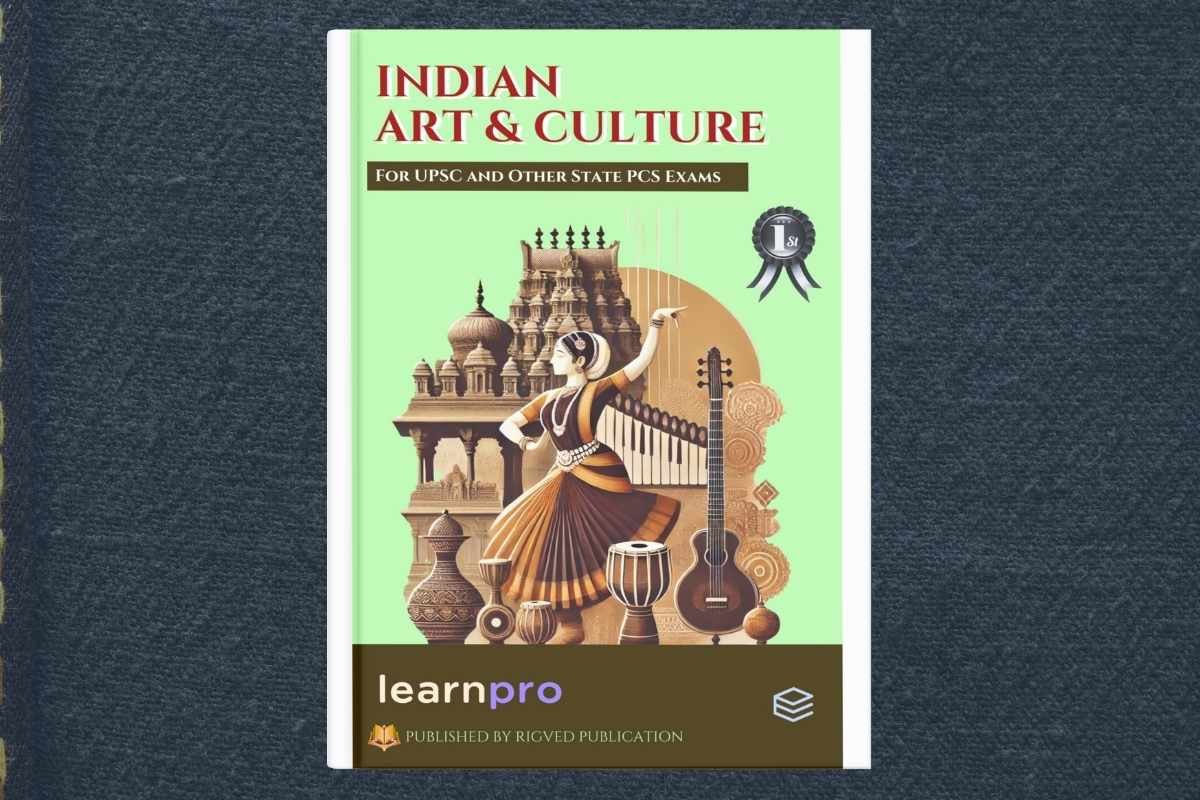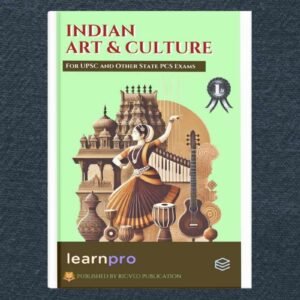Indian Art & Culture Notes for UPSC and State PCS Exam
Original price was: ₹299.00.₹129.00Current price is: ₹129.00.
Indian Art & Culture Notes for UPSC and State PCS Exam is your go-to resource for mastering India’s rich cultural heritage in a structured and easy-to-understand manner. Covering Architecture, Sculpture, Painting, Music, Dance, Literature, Religions, Festivals, Handicrafts, and Cultural Institutions, this guide simplifies complex topics with historical insights, key facts, and exam-relevant details. Designed to meet the demands of Prelims, Mains, and Interview preparation, it ensures a well-rounded understanding, making learning both efficient and engaging. Whether you’re revising or starting fresh, this resource will enhance your preparation with clarity and depth.
Guaranteed Safe Checkout
- Satisfaction Guaranteed
- No Hassle Refunds
- Secure Payments
Description
Indian Art & Culture Notes for UPSC and State PCS Exam
1. Introduction to Indian Art & Culture
- Definition of Culture and its Components
- Sources of Indian Culture (Literary, Archaeological, Foreign Accounts)
- Evolution of Indian Art & Cultural Heritage
- UNESCO World Heritage Sites in India (Cultural)
2. Prehistoric and Protohistoric Art
- Paleolithic, Mesolithic, and Neolithic Art
- Rock Art (Bhimbetka Caves)
- Indus Valley Civilization Art
- Town Planning
- Sculptures and Seals
- Pottery and Ornaments
3. Indian Architecture through the Ages
A. Ancient Indian Architecture
- Mauryan Art and Architecture (Pillars, Stupas, Caves)
- Post-Mauryan Developments (Shunga, Satavahana, Kushana)
- Gupta Period Architecture (Temples, Caves, Monasteries)
B. Medieval Indian Architecture
- Early Medieval Temple Architecture (Nagara, Dravida, Vesara Styles)
- Islamic Influence on Indian Architecture (Delhi Sultanate, Mughal Architecture)
- Regional Kingdoms and their Architectural Contributions (Vijayanagara, Rajput, Deccan, Sikh, Maratha Architecture)
C. Modern Indian Architecture
- British Colonial Architecture
- Indo-Saracenic Style
- Post-Independence Architecture (Le Corbusier, Charles Correa)
4. Indian Sculpture and Iconography
- Mauryan and Post-Mauryan Sculptures (Yaksha-Yakshi, Gandhara, Mathura, Amravati Schools)
- Gupta Period Sculptures (Dashavatara Temple, Deogarh)
- Chola Bronzes and South Indian Iconography
- Medieval Sculptural Traditions (Hoysala, Pallava, Chalukya)
5. Indian Paintings
- Prehistoric Rock Paintings (Bhimbetka)
- Mural Paintings (Ajanta, Ellora, Bagh, Sittanavasal)
- Miniature Paintings (Pala, Jain, Mughal, Rajput, Kangra, Pahari, Deccan)
- Modern Indian Paintings (Raja Ravi Varma, Bengal School, Progressive Artists Group)
6. Indian Music
A. Classical Music
- Hindustani Classical Music (Gharanas, Ragas, Instruments)
- Carnatic Classical Music (Kritis, Ragas, Composers)
- Classical Music Instruments (String, Percussion, Wind)
B. Folk and Tribal Music
- Regional Music Forms (Bihu, Baul, Lavani, Pandavani, Bhavageete)
- Devotional and Sufi Music (Bhakti & Sufi Traditions)
7. Indian Dance Forms
- Classical Dance Forms (Bharatanatyam, Kathak, Kathakali, Odissi, Kuchipudi, Manipuri, Sattriya, Mohiniyattam)
- Folk Dances of India (Bihu, Garba, Ghoomar, Chhau, Yakshagana, Bhangra, Kalbelia)
- Dance Institutions and Government Initiatives
8. Indian Theatre and Puppetry
- Sanskrit Theatre (Natyashastra, Kalidasa’s Works)
- Folk Theatre (Nautanki, Jatra, Tamasha, Bhavai, Therukoothu)
- Modern Indian Theatre
- Puppetry Traditions (Kathputli, Shadow Puppets, String Puppets, Glove Puppets)
9. Indian Literature
A. Ancient Indian Literature
- Vedic Literature (Shruti, Smriti, Upanishads, Puranas)
- Sanskrit Epics (Ramayana, Mahabharata)
- Buddhist and Jain Literature (Tripitaka, Jataka, Agamas)
B. Medieval Indian Literature
- Bhakti & Sufi Literature (Kabir, Tulsidas, Mirabai, Guru Nanak)
- Persian and Urdu Literature (Amir Khusrau, Ghalib)
C. Modern Indian Literature
- Colonial Period Writers (Bankim Chandra Chatterjee, Rabindranath Tagore, Premchand)
- Post-Independence Indian Literature (R.K. Narayan, Mulk Raj Anand, Arundhati Roy)
10. Indian Religions and Philosophy
- Hinduism (Vedas, Upanishads, Puranas, Smritis, Bhagavad Gita)
- Jainism and Buddhism (Teachings, Scriptures, Influence)
- Sikhism (Guru Granth Sahib, Teachings of Gurus)
- Islam and Christianity in India
- Philosophical Schools (Vedanta, Nyaya, Samkhya, Yoga, Mimansa)
11. Festivals of India
- Religious Festivals (Diwali, Holi, Eid, Christmas, Baisakhi, Guru Purab)
- Harvest Festivals (Pongal, Bihu, Onam, Makar Sankranti)
- Cultural and Regional Festivals
12. Indian Crafts and Handicrafts
- Textiles (Banarasi Silk, Chikankari, Kalamkari, Pashmina, Bandhani)
- Metal Crafts (Dhokra, Bidriware, Kundan, Meenakari)
- Pottery (Blue Pottery, Terracotta, Black Pottery)
- Tribal and Folk Art (Warli, Madhubani, Pattachitra, Gond)
13. Indian Cinema and Television
- Evolution of Indian Cinema (Silent Era, Talkies, Bollywood, Regional Cinema)
- Contribution of Indian Cinema to Freedom Struggle
- National Film Awards and Major Indian Filmmakers
- Growth of Indian Television and Digital Media
14. Cultural Institutions and Policies
- Important Cultural Institutions (ASI, IGNCA, Sangeet Natak Akademi, Sahitya Akademi)
- Government Schemes for Cultural Preservation (HRIDAY, PRASAD, Kala Sanskriti Vikas Yojana)
- International Cultural Relations (ICCR, UNESCO)
15. Indian Martial Arts and Traditional Games
- Martial Arts (Kalaripayattu, Gatka, Thang-Ta, Silambam)
- Traditional Games (Kabaddi, Kho-Kho, Mallakhamb, Chess)


Reviews
There are no reviews yet.